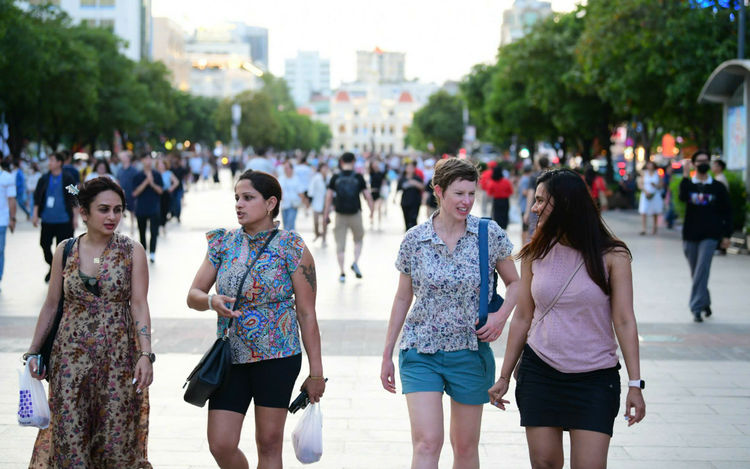
Foreigners visit Ho Chi Minh City. Photo: Quang Dinh / Tuoi Tre
A recent macroeconomic analysis report by Saigon - Hanoi Securities JSC (SHS) has shed new light on the cost structure of inbound travel, raising a critical question—are high international airfares undermining Vietnam’s appeal to foreign tourists?
Airfare barrier despite local affordability
The May report indicated that Vietnam offers competitive prices on accommodation, food, and entertainment, often up to 30 percent cheaper than neighboring Thailand.
However, this cost advantage is affected by the steep cost of international flights to the country, particularly for long-haul travelers from Europe and America.
For travelers from the U.S., Germany, and France, flying to Vietnam costs an average of US$1,063, slightly higher than to Thailand ($1,050) and Malaysia ($1,037), but lower than to Indonesia ($1,200).
Meanwhile, travelers from Asian countries such as Japan, South Korea, and China pay around $358 to reach Vietnam, $433 to Thailand, $426 to Malaysia, and $466 to Indonesia.
While this might suggest Vietnam is relatively well-positioned in terms of flight affordability for short-haul travelers, the longer-distance markets—those with higher spending potential—tell a different story.
SHS emphasized that for these tourists, airfare constitutes a large portion of the trip’s total cost.
According to the report, airfares account for up to 75 percent of the travel budget for budget-conscious tourists to Vietnam, and still make up a significant share even for mid-range and premium travelers.
This cost distribution heavily restricts spending on other high-value sectors such as accommodation, dining, shopping, and entertainment, which are seen as key revenue streams for tourism.
While Vietnam’s overall cost competitiveness remains strong, the weight of airfares tips the scales.
Visitors are paying nearly the same, or more, for a trip to Vietnam as to other destinations in the region.
The difference of six to 10 percentage points in airfares might seem small numerically, but it is enough to shift traveler preferences, particularly when tourists consider total trip value.
Factors behind high airfares
Rising jet fuel prices, the weakened Vietnamese dong against the U.S. dollar, and a small number of aircraft and carriers were among contributors to high airfares, according to the report.
However, the root problem lies in people and how the aviation market is regulated and shaped.
“The absence of real competition keeps prices high,” SHS said.
To address the airfare challenge, SHS hinted at encouraging new carriers to enter the local market, adjusting seasonal airfare caps to reflect demand more flexibly, offering subsidies for large-scale charter flights from Europe and the U.S., and expanding aviation partnerships with major airlines from the Middle East and Europe to open more direct routes.


Max: 1500 characters
There are no comments yet. Be the first to comment.